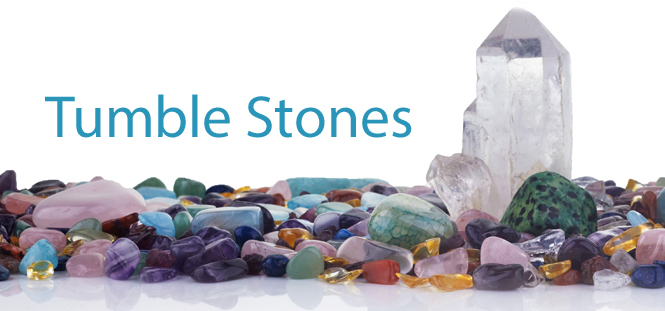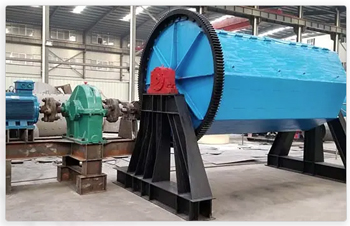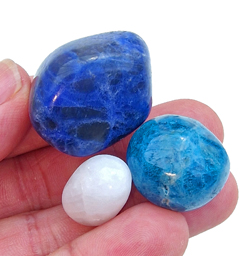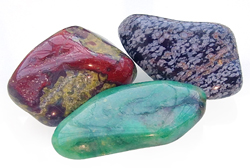
What are Tumble Stones
Here at ShamansCrystal we provide an extremely wide variety of Gemstone Tumble stones originating from all over the world. Over 150 difference types of stones as a minimum. We supply these stones to both Retail and Wholesale customers, but firstly what are tumble stones?
Tumble stones, also known as tumbled stones or polished stones, are small, rounded, and smooth gemstones or minerals that have undergone a process called tumbling. The tumbling process is a method of polishing and shaping rough stones to create attractive and polished pieces suitable for use in Holistic Healing, Gem Collection, jewellery, crafts, or as decorative items.
Tumble stones can be both crystals and stones. The term "tumble stones" is a broad and inclusive description that encompasses various types of gemstones, minerals, crystals, and rocks that have undergone the tumbling process.
Are Tumble crystals? Many tumble stones are indeed crystals. Crystals are naturally occurring mineral formations with a specific atomic and molecular structure, resulting in their unique physical properties. Examples of crystal tumble stones include clear quartz, amethyst, rose quartz, citrine, and others. Crystals are often valued for their aesthetic beauty, healing properties, and metaphysical attributes.
 Here's an overview of how tumble stones are made:
Here's an overview of how tumble stones are made:
Rough stones selection: The process begins with selecting rough gemstones or minerals that are suitable for tumbling. These stones are usually sourced from mines or natural deposits and come in various shapes and sizes.
Cleaning: Before the tumbling process starts, the rough stones need to be cleaned to remove any dirt, debris, or impurities.
Tumbling machine: The cleaned rough stones are placed inside a tumbling machine, which is a barrel-like device. This machine consists of a motor that rotates the barrel, causing the stones to tumble and move around inside.
Abrasive grits: The stones are mixed with abrasive grits, which are coarse substances such as silicon carbide or diamond. These grits help in smoothing and shaping the stones during the tumbling process.
Tumbling stages: The tumbling process typically consists of multiple stages, with each stage using finer and finer grits. The stones stay in the tumbler for a specific period during each stage, gradually wearing down rough edges and surfaces.
Polishing stage: After the stones have gone through the abrasive stages, they are moved to a polishing stage. In this stage, a fine polishing compound is added to the stones, giving them a smooth and shiny finish.
Rinse and dry: Once the polishing stage is complete, the stones are removed from the tumbler, rinsed thoroughly to remove any remaining grit or polishing compound, and then dried.
Sorting and grading: After drying, the tumble stones are sorted based on size, shape, colour, and quality. Only the best-looking stones that meet specific criteria are chosen for sale or further use.
It's essential to note that the tumbling process can take several weeks, depending on the desired outcome or the hardness of the stones being tumbled. Different types of stones may require different tumbling times and grits to achieve the desired results. These differences can affect the price as much as the type rarity of the stone being tumbled, for example softer stones like Satin Spar Selenite may fracture and by split by the process whereas harder quartz stones will lose little through the process.
Stone Shapes and Sizes
Shapes can and do vary greatly, from flat oval, round spherical and every kind of irregular shape in between. This variance occurs mostly due to the random nature of the tumbling process with the varying hardness of the stones involved. Furthermore, the shape of the stones placed into the tumbling machine will also have an effect. Some manufacturers will attempt to pre-shape some stones before the tumbling process, in attempt to make larger squarer stones, this can increase the cost of batches that have had that extra prep work.
For all these reasons we work hard to keep our images of tumble stones accurate to the current batch. Hence you will see in some instances we present some gems as Batch 1, or Batch 2.
In the images we present on any listing we attempt to display the potential variance of the stones within the batch. This is why the image shows more than 1 stone and yet in many instances we are selling the stone singly. In our experience, if we show 1 stone, then we don’t fairly represent the potential variance. So please read the descriptions. They should be clear, the term SOLD SINGLY appears.
Sizes

We currently sort the stones into 3 sizes. There are potentially more sizes and you will find that not all sizes are standard across the market place. Our sizes are measured on the Long axis and are;
1-1.5cm (between 1 and 1.5cm wide)
2-2.5cm (between 2 and 2.5cm wide)
3-3.5cm (between 3 and 3.5cm long
These sizes are the minimum promise. As you can see, there are intentional gaps in the sizing. So there is the potential you can get stones that are larger, but you shouldn’t get sizes that are smaller. We constantly monitor the size promise against the stock we have to ensure we meet our promise.
Prices
Most of the time we buy tumbles stones on a weight price, by the kilo. We then we size them and sort them, set a kilo price and divide the stock to achieve a unit per stone price.
On many stones, we also set quantity discounts, so you can save on bulk requirements even if you are not a trade customer.
Here is Link for Using your Tumble Stones
Here is a link to review or buy our Tumble Stones Category
Here is a link to review or Buy our Wholesale Listings on Ebay.

